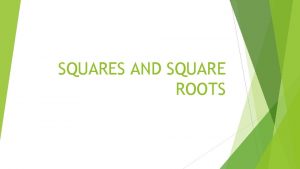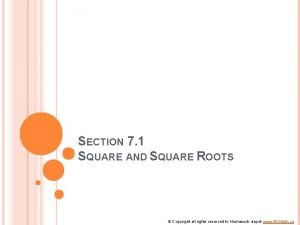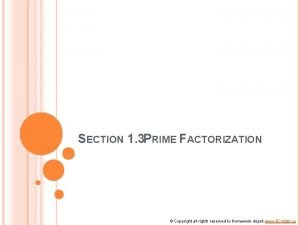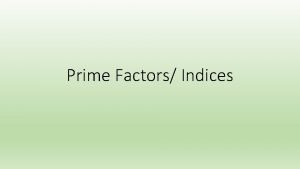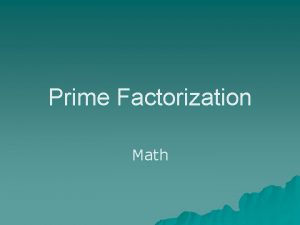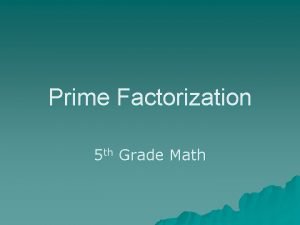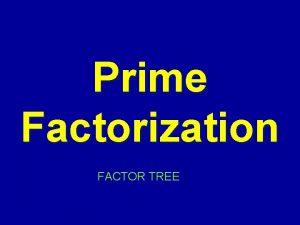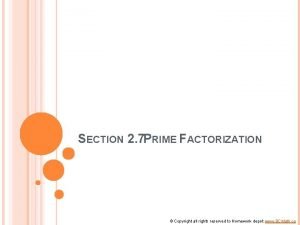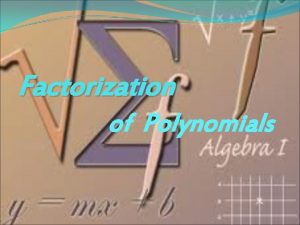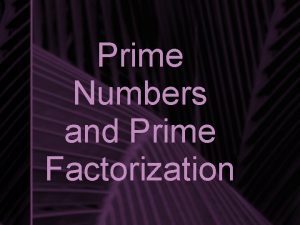SECTION 1 3 PRIME FACTORIZATION Copyright all rights











- Slides: 11

SECTION 1. 3 PRIME FACTORIZATION © Copyright all rights reserved to Homework depot: www. BCMath. ca

I) WHAT ARE FACTORS? An integer which evenly divides a number without leaving a remainder ie: What are all the factors of 24? {1 , 2, 3, 4, 6, 8, 12, 24} A number with only two factors are called: “Prime Numbers” Ie: List all the prime numbers less than 100: © Copyright all rights reserved to Homework depot: www. BCMath. ca

Ex: Two prime numbers have a sum of 84679. What is their positive difference?

II) PRIME FACTORIZATION A decomposition of a number where all its factors are prime numbers Use the divisibility rules to break the numbers down ie: Find the Prime Factorization of the following numbers © Copyright all rights reserved to Homework depot: www. BCMath. ca

III) PERFECT SQUARES AND CUBES In order to be a perfect square, all the exponents of the prime factors must be even ie: All the exponents of the prime factors are even! In order to be a perfect cube, all the exponents of the prime factors must be a multiple of 3 ie: All the exponents of the prime factors are multiples of 3! © Copyright all rights reserved to Homework depot: www. BCMath. ca

EX: WHAT IS THE LOWEST VALUE OF “K”, WHERE “K” IS AN INTEGER, SO THATN”“ IS A PERFECT SQUARE? © Copyright all rights reserved to Homework depot: www. BCMath. ca

For what integer n > 0 is the equation true for all value of “k”?

If “N” is the product of three different primes, then its least possible value will be 30 because If “N” is less than 100, what is the largest possible value for “N”? Now do the same thing if “N” is less than 1000, what is the largest possible value for “N”?

CHALLENGE: GIVEN THAT “A” AND “B” ARE POSITIVE INTEGERS, FIND ALL THE POSSIBLE VALUES OF (A, B) SUCH THAT: EUCLID

MATH PRIZE FOR GIRLS 2015

HOMEWORK
 Copyright 2015 all rights reserved
Copyright 2015 all rights reserved Copyright 2015 all rights reserved
Copyright 2015 all rights reserved Dell all rights reserved copyright 2009
Dell all rights reserved copyright 2009 Copyright © 2018 all rights reserved
Copyright © 2018 all rights reserved Factors of 145
Factors of 145 Prime factorization of 84 using exponents
Prime factorization of 84 using exponents Estimating square roots word problems
Estimating square roots word problems All the perfect squares
All the perfect squares 120 prime factorization
120 prime factorization Factor tree for 64
Factor tree for 64 Prime numbers between 101 and 200
Prime numbers between 101 and 200 Prime factors of 60 in index form
Prime factors of 60 in index form






